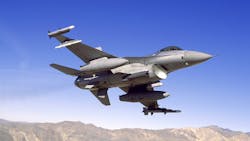Lockheed Martin to build legacy electro-optical targeting avionics pods for U.S. allied combat aircraft
ROBINS AIR FORCE BASE, Ga. – Lockheed Martin Corp. is building new versions of legacy electro-optical combat jet target systems for U.S. allies under terms of a $485 million contract announced Monday.
Officials of the U.S. Air Force Life Cycle Management Center at Robins Air Force Base, Ga., are asking the Lockheed Martin Missiles and Fire Control segment in Orlando, Fla., to build the Sniper Advanced Targeting Pods (ATP) system; upgraded versions of the Low Altitude Navigation and Targeting Infrared for Night (LANTIRN) navigation pod; and aircraft Infrared Search and Track (IRST) system.
These combat avionics systems will go to U.S. allies such as Bahrain, Belgium, Bulgaria, Canada, Egypt, Greece, Indonesia, Iraq, Israel, Jordan, South Korea, Kuwait, Morocco, The Netherlands, Norway, Oman, Pakistan, Poland, Qatar, Romania, Saudi Arabia, Slovakia, Taiwan, Thailand, and Turkey.
The Sniper Advanced Targeting Pod provides precision targeting and situational awareness to combat aircraft crews, and is among the most widely deployed targeting system for fixed-wing aircraft in use by the U.S. Air Force and U.S. allies.
The pod provides precision strike, as well as non-traditional intelligence, surveillance, and reconnaissance (NTISR) for close air support of ground forces. The pod has electro-optical imagery capability, a video datalink, and J-series coordinates.
The pod has image processing algorithms, stabilization, high-resolution, mid-wave forward-looking infrared (FLIR) and daylight TV sensors, dual-mode laser for geo-location, laser spot tracker, infrared marker, meta-data for video, and common software and hardware interfaces.
The pod has been flown on U.S. Air Force and international F-15E, F-16, B-1, A-10C, Harrier GR7/9, and CF-18 combat aircraft, and is suitable for the B-52 strategic bomber.
LANTIRN is a combined navigation and targeting pod system for use on the F-15E Strike Eagle and F-16 Fighting Falcon. It enables these aircraft to fly at low altitudes, at night, and under-the-weather to attack ground targets with a variety of precision-guided weapons.
The LANTIRN's AN/AAQ-13 navigation pod provides high-speed penetration and precision attack on tactical targets at night and in adverse weather, and contains a terrain-following radar and a fixed thermographic camera, which provides a visual cue and input to the aircraft's flight control system, enabling it to maintain a pre-selected altitude above the terrain and avoid obstacles.
The system's AN/AAQ-14 targeting pod contains a high-resolution, forward looking infrared sensor, which displays an infrared image of the target to the pilot; a laser designator and rangefinder for precise delivery of laser-guided munitions; a missile boresight; and software for automatic target tracking. LANTIRN has been in full-rate production since 1986.
IRST is a longwave infrared detection system that targets aircraft in a radar-denied environment. The system uses infrared search and track technology to detect and provide weapon-quality track solutions on potentially hostile aircraft.
Related: Raytheon to provide UAV electro-optical targeting systems in $50.2 million contract
The system has a processor, inertial measurement unit, and environmental control unit that fit inside the sensor pod, which attaches to a weapons station underneath the aircraft.
Infrared sensors like the IRST detect the heat from an aircraft's engine exhaust or even the heat generated by the friction of an aircraft as it passes through the atmosphere. Unlike radar, infrared sensors do not emit electronic signals, and do not give away their presence to adversaries.
On this contract Lockheed Martin will do the work in Orlando, Fla., and at locations to be identified with each order, and should be finished by May 2025. For more information contact Lockheed Martin Missiles and Fire Control online at www.lockheedmartin.com, or the Air Force Life Cycle Management Center-Robins at www.robins.af.mil/Units/AFLCMC.
